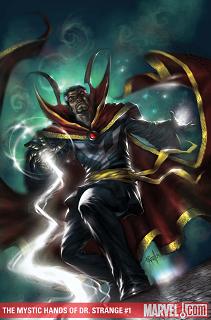 Marvel's latest Super Issue homaging its Seventies black and white magazine line features Dr Strange in four tales, three of which are very much of 'their' time, all of which are different enough from current stories to justify their inclusion.
Marvel's latest Super Issue homaging its Seventies black and white magazine line features Dr Strange in four tales, three of which are very much of 'their' time, all of which are different enough from current stories to justify their inclusion. Kieron Gillen's piece, in which Strange tackles an offbeat cult leader out to remake the world in his image, leaves the reader questioning whether our hero has done the right thing. The Seventies vibe is there from the opening scene of Strange and disciple Wong shopping in a Greenwich Village full of trendy hipsters, immediately evoking the work of such classic creators as Steve Englehart and Frank Brunner. If there were any doubt, their Sise-Neg storyline is indirectly referred to by Strange in a clever bit of business. And the villain of the piece has rarely been better portrayed, the snide old git.
Fraser Irving, aside from giving us the creepiest image of Strange's gal pal Clea ever, produces magical effects that would look great in colour. The washes and greyscales look good, nevertheless, and it's full marks for eeriness, with the androgynous appearance of the antagonistic Doktor also keeping the reader on their toes.
The great Frank Brunner himself illustrates Peter Milligan's story of a melancholic Strange helping a weak man tackle his inner demons. There's unapologetic talk of sex, a scene of domestic violence and a subtle likening of Strange's spells to recreational drugs. Milligan mixes ideas and actions with ease in this impressive outing. And no one does a better brooding Strange than Brunner. As for his Wong, the manservant's knowing looks, coupled with the narrative references to his special noodle sauce (easy!), had me wondering if it were his 'powers' rather than his master's, which finally lift their caller's mood.
Writing and drawing, Ted McKeever ups the philosophical talk to the extent that I found his contribution nigh-unintelligible in terms of dialogue. There's a drunk, suicidal Strange, a vagrant turned talking head and a demon tempter. I suspect it's all an allegory for dealing with addiction. Beats me, but I think I got the gist of proceedings and liked the air of oddness that dominated. And McKeever's illustrations, here sinister, there amusing, are fascinating to look at.
The Seventies sensibility in terms of story tone is absent from Mike Carey and Marcos Martin's short, but it's there so far as format goes - this is prose with spot illoes rather than stripwork. The first person narrative concerns Strange's debut encounter with a servant of Dormammu. With flashy graphics barely available, Carey concentrates on the cerebral, as Strange discerns a magical rule or two. Marcos Martin - who co-created The Oath, the best Strange tale in recent memory - does a lap of honour here. His three images bring Carey's words to richer life.
Lucio Parrillo's cover shot perfectly evokes Marvel Magazines' top cover artist, Earl Norem, but it's far too dark. As the only colour page, this should dazzle the reader, but poor Dr Strange looks as if he's been down a coal mine.
If you're a fan of Dr Strange, you should enjoy this return to his glory days. And if you've never got the appeal of the character, there's even more reason to try it.
Excellent review, save for one slight error:
ReplyDeleteIt wasn't the Sise-Neg incident that was being referred to in the story (although Doc did witness the destruction and rebirth of the universe THEN, as well).
The story in question is instead from Doctor Strange Master of the Mystic Arts # 10 - 13 (issues # 12-13, more specifically) when the world was destroyed via Mordo's madness and Eternity restored it, recreating everything as it was - except for Strange, who was the sole original.
As I mention in my own review of this wonderful oneshot special (found at this link -
http://tinyurl.com/MHoDS1-review ), that long-ago storyline was one of my all-time faves, which unfortunately, was undone by editorial fiat a few issues later (thus making it a "test" by the Ancient One).
Yes, I know... uber-nerdy of me.
But mine is a Doctor Strange-centric blog and these are the things to which my brain focuses.
;-)
~P~
PTOR
Sanctum Sanctorum Comix
Thanks so much Ptor, my copies of Marvel UK's presentations of those stories are miles away, apologies for my rubbish memory.
ReplyDeleteHaving read all the old Doctor Strange stories in the Marvel UK weeklies, it still seems a novelty to see him in colour!
I'm off to read your thoughts!